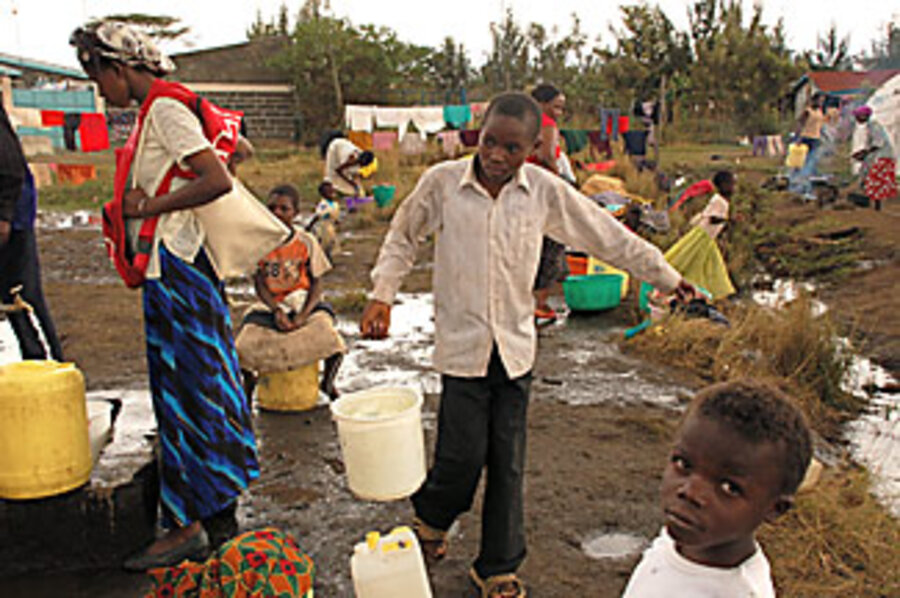Uprooted Kenyans long to return home
Loading...
| Nakuru, Kenya
When the mob of young men came to his door on New Year's Eve, carrying kerosene jugs and machetes and bellowing an ominous war chant, farmer Moses Mbugua gathered his family of six and ran, just as he had after elections in 1992 and 1997.
This time, however, he was one of 500,000 Kenyans who were forced to flee their homes as ethnic clashes that killed more than 1,200 people tore through the country in the wake of the disputed Dec. 27 presidential election.
Mr. Mbugua's family eventually found its way to a camp for other displaced members of their Kikuyu tribe outside this city in Kenya's southern Rift Valley region.
Three months later, the camp still houses 16,400 people in cramped white tents supplied by the United Nations. But unlike in past years when he was chased off his land by resentful neighbors, Mbugua says he will not return to the land he owns near the city of Eldoret.
"This time they destroyed everything: They burned my house and crops, stole my cattle, and killed some of my friends," he said. "We cannot go back there, because it is unsafe."
The prospects of internally displaced people (IDPs) like Mbugua returning home anytime soon were further dampened this week as rioting broke out in several cities after the opposition suspended power-sharing talks with the government. Compounding the situation is the fact that many of the IDPs cannot return home to till the fields, prompting concerns of a looming food shortage at a time when prices for basic foods are skyrocketing.
About half of the IDPs are still in camps, while the other half are with family members or receiving shelter from other communities, according to the Office of US Foreign Disaster Assistance.
The Kenya Land Alliance says that more than half of the IDPs tilled some of Kenya's richest farmland in the Rift Valley. According to a February assessment by the government and international NGOs, land cultivation may be reduced by up to 30 percent during the April-May planting season because of farmer displacement and higher production costs. The assessment concluded that the cutbacks in planting will likely lead to "decreased food production and negatively impacted food security throughout Kenya."
The timing for a reduced food supply in Kenya would be difficult, as swiftly climbing food and fuel prices, a falling dollar, and the demand for biofuels are straining World Food Program (WFP) stocks allocated for hunger crises. Food reserves are at their lowest in 30 years while prices of staple foods have risen by up to 40 percent in the last six months, according to the WFP.
"We cannot afford to lose any more days that could be used for planting," WFP executive director Josette Sheeran told reporters in Nairobi last week.
As Mbugua fled his five-acre farm, he saw the fire devouring the granary he'd filled with corn, beans, and peas to sell at local markets.
"They believe the land we are living on is theirs," Mbugua said of his attackers, who are members of the Kalenjin ethnic group. "To them we are visitors and we have to leave that place because it is their ancestral land."
The conflict between the Kikuyu and the Kalenjin dates back to the mid-20th century, when many Kikuyus moved to the Rift Valley from their ancestral Central Province to work on land owned by white British settlers. After Kenyan independence in 1963, some Kikuyus were able to buy the land from the government as part of a resettlement scheme, according to Catherine Gatundu, deputy coordinator of the Kenya Land Alliance.
"The people who consider the Rift their ancestral land continue to feel aggrieved," says Ms. Gatundu. "This violence will keep happening in election years until the government deals with land claims."
Mbugua and many other farmers in the Nakuru IDP camp are hoping the government will provide them with a solution – either security and startup funds at home so that they can return, or a resettlement package to start over somewhere else.
According to a government strategy paper released March 8, the resettlement and reintegration of IDPs is under way. But IDPs say the calls to go home ring hollow.
Lucy Njoki, a 106-year-old Kikuyu woman in the Nakuru camp, said she ran from her home in Kericho when the Kalenjin attackers arrived. Though she was chased from her home in previous election years and camped out for up to six months, she says this time is different.
"I would rather die in this camp than go back to that place," Ms. Njoki says. "I feel like they are still there waiting for me."
Some experts like Gatundu say that rather than returning home, many IDPs will eventually integrate into slums in cities like Nakuru, as some Kikuyus have done in past election years.
Meanwhile, their land may lie unused because the Kalenjins who chased them away cannot claim the land without the proper legal documents.
"So much of the land will lie fallow, and that will have a great impact on food security," says Gatundu.
Mbugua says the monotony and hopelessness of the camp weighs on him.
"Here in this camp, we are living desperately and have no way ahead," he says, "but we are still hoping that our God will remember us."





